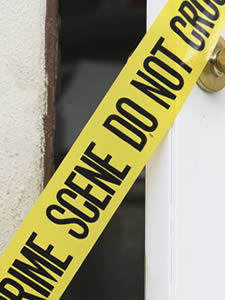- 01: Introduction
- 02: History
- 03: Propellants, Firearms, and Ammunition Development
- 04: Modern Firearms Manufacture
- 05: Small Arms Ammunition
- 06: Evidence Handling Procedures
- Introduction
- Objectives
- AFTE Knowledge and Ability Factors
- Types of Evidence
- Associative Evidence
- The Crime Scene
- Evidence Submission
- Laboratory Evidence Handling
- Case Tracking Within the Laboratory
- Firearm and Toolmark Examination Considerations
- Selected Bibliography
- 07: Equipment and Instrumentation
- 08: Examination of Firearms
- 09: Cartridge and Shotshell Examination
- 10: Characterization and Evaluation of Fired Projectiles
- 11: Bullet Comparison and Identification
- 12: Gunshot Residue and Distance Determination
- 13: Toolmark Identification
- 14: Communicating Results
- Resources


Protecting the Scene
Home > Evidence Handling Procedures > The Crime Scene > Protecting the Scene
The crime scene must be protected to minimize the risk of contamination and loss of evidence. For example, coughing or sneezing may introduce contaminating DNA into biological samples. Footprints left by a perpetrator may be inadvertently destroyed by a nonessential observer.

Limited access crime scene
Access to a scene should be limited to those with a need to be present. An officer with the power to control access must be placed in charge of the scene. The perimeter must be secured, and a log must be kept of persons allowed entry.
Some scenes require the participation of specialist personnel, such as a medical examiner or crime laboratory analyst. Such personnel should be aware of the basic principles of crime scene investigation. The officer in charge of the scene should make certain that specialist personnel adhere to processing protocol and maintain the integrity of the crime scene.
Crime laboratory analysts called to assist at a crime scene should adhere to laboratory policies in documenting their search and collecting evidence.
Appropriate personal protection equipment must be worn for the safety of the wearer and to prevent contamination of the scene.




